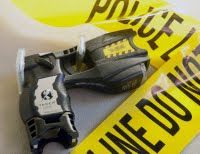What are Tasers?
Tasers are hand-held weapons that deliver a jolt of electricity through a pair of wires propelled by compressed air from up to 10.6 metres away.The jolt stuns the target by causing an uncontrollable contraction of the muscle tissue. The target is immobilized and falls to the ground — regardless of pain tolerance or mental focus.
Taser stands for “Thomas A. Swift Electric Rifle.” It is named after a series of children’s science-fiction novels written in the early 20th century featuring the young genius inventor Tom Swift.
Who makes them?
Arizona-based Taser International makes virtually all of the stun guns being used today. The technical term for a stun gun is a “conducted energy device” (CED) or “conducted energy weapon” (CEW).Taser International says more than 13,400 law enforcement, correctional and military organizations in 44 countries use its devices. Of these agencies, more than 5,000 of them equip all of their patrol officers with Tasers, the company asserts. Since early 1998, more than 375,000 Taser brand immobilizers have been sold to law enforcement agencies.
There are two main types of stun guns made by Taser used by law enforcement agencies:
- M26: A high-powered weapon marketed to police forces to stop “highly combative individuals.” A burst of compressed nitrogen launches two small probes attached to the device by conductive wires. From as far as 10.6 metres, the device transmits electrical pulses through the wires to immobilize a person. Also has a laser sight for aiming.
- X26: A smaller model introduced in 2003. Launches two small probes as far as 10.6 metres.
- C2: Introduced in 2007, smaller than its predecessors and comes in nine colours. Launches two probes as far as 4.5 metres.
- X26C: Modelled after the X26 but formatted for personal use. Has a range of 4.5 metres.
- Advanced Taser M18/M18L: Modelled after the M26 with a range of 4.5 metres.
In Canada, however, Tasers are a prohibited weapon. Only one company can import them into Canada under a special permit, and they can only sell the devices to law enforcement agencies, said RCMP Cpl. Greg Gillis, who trains police officers in how to use Tasers. Each Taser sale is registered and tracked, much like a handgun, he said.
In 2007, 85 per cent of the company’s $100.7 million US in revenue came from sales within the United States.
What are the benefits of stun guns?
Tasers are supposed to allow police officers to subdue violent individuals without killing them. A police officer can “take down” a threatening suspect without worrying that a stray bullet might kill or injure an innocent bystander.“There’s no question that there are certainly lots of documented examples in Canada where had we not had the Taser and had to respond with more traditional options, that it could have resulted in a higher level of force,” said Cpl. Gillis. “For example, the firearm: … with a firearm, there are only two outcomes — … it’s going to be a permanent injury or a loss of life.”
“We don’t speak often enough about the number of lives that have been saved, the number of people that are up and walking around today that might not have been had it not been for a Taser,” says Steve Palmer, executive director of the Canadian Police Research Centre. The CPRC is a partnership among the Canadian Association of Chiefs of Police, the RCMP and the National Research Council of Canada.













No comments:
Post a Comment